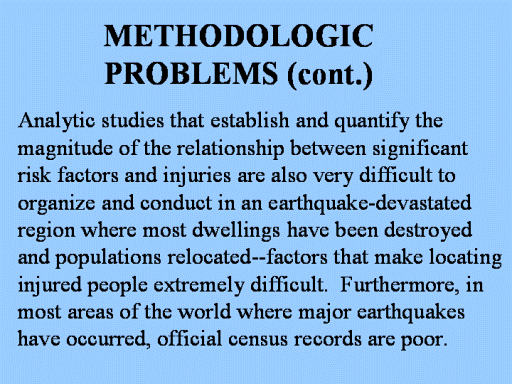| front |1 |2 |3 |4 |5 |6 |7 |8 |9 |10 |11 |12 |13 |14 |15 |16 |17 |18 |19 |20 |21 |22 |23 |24 |25 |26 |27 |28 |29 |30 |31 |32 |33 |34 |35 |36 |37 |38 |39 |40 |41 |42 |43 |44 |45 |46 |47 |48 |49 |50 |51 |52 |53 |54 |55 |56 |57 |58 |review |
 |
Even when good census data
are available, as in California, other factors such as the
proportion
of
people commuting to and from the affected area may greatly affect
the size of the population present at the actual time of the
earthquake. Thus, even
estimating the population at risk may be difficult, let alone
selecting appropriate control subjects (133).
As a result, almost all of the published epidemiologic
studies on earthquake-related injuries are descriptive rather than
the analytic studies necessary to test hypotheses that particular
types of exposures or hazards (e.g., collapsing buildings) are
associated with injuries.
(See chapter on Practical
Application of Epidemiologic Methods for Disasters [Chapter 2], for
a
more
in-depth discussion of the problems of conducting studies following
disasters [e.g., collecting reliable data on injuries under
difficult field conditions, collecting "perishable" data, dealing
with a lack of definition of disaster-related injury, working with
poor documentation in medical records, and selecting appropriate
control subjects]).
|